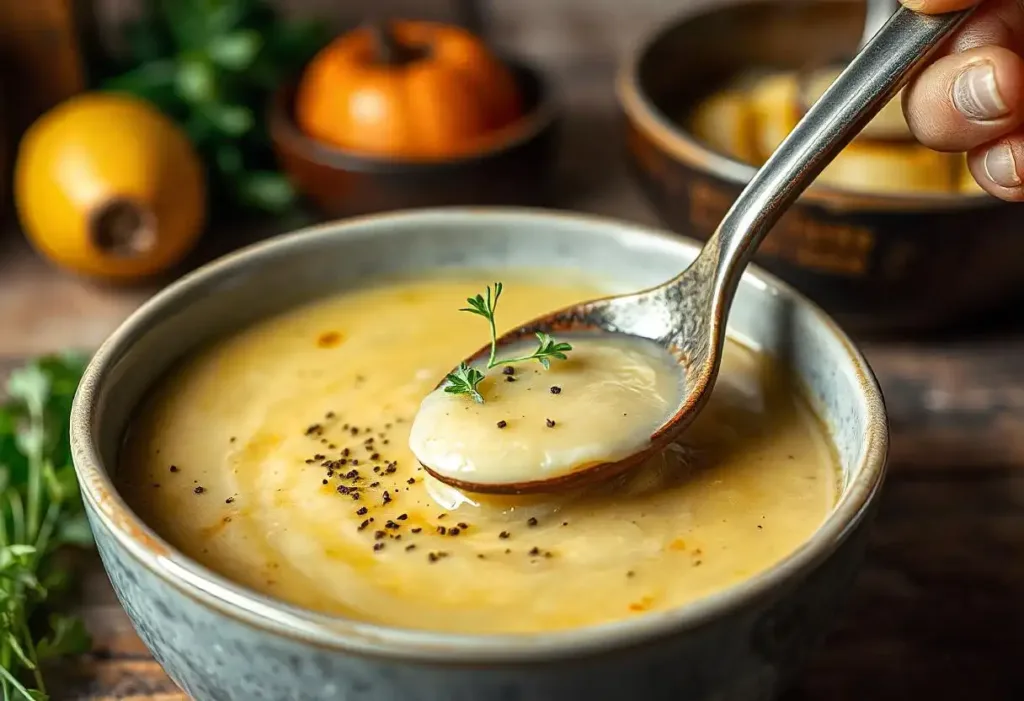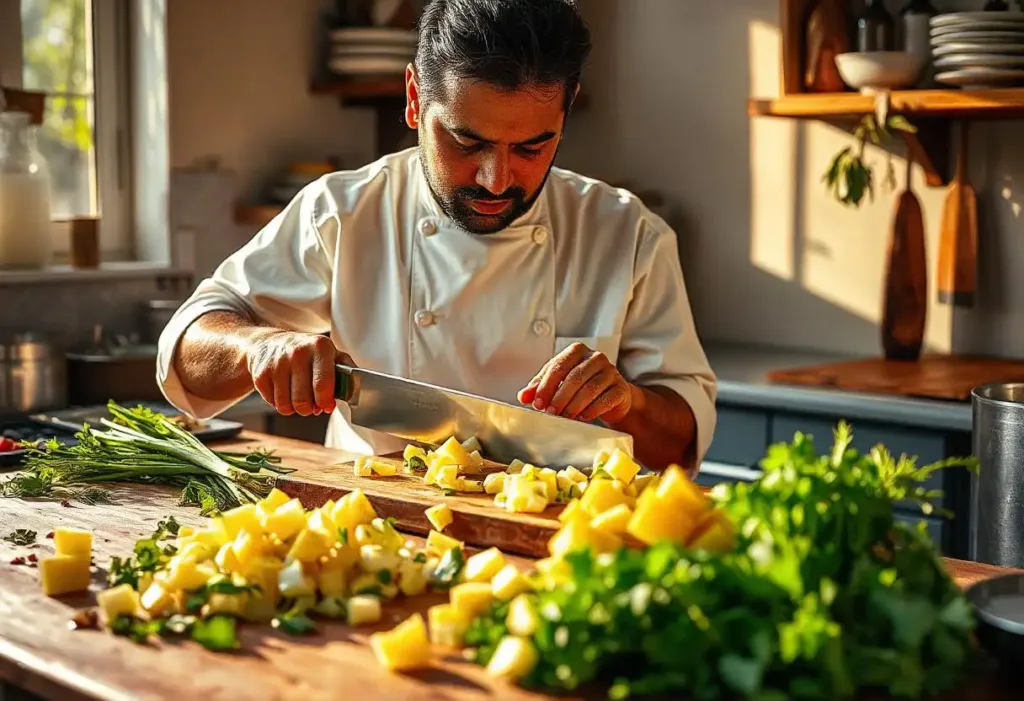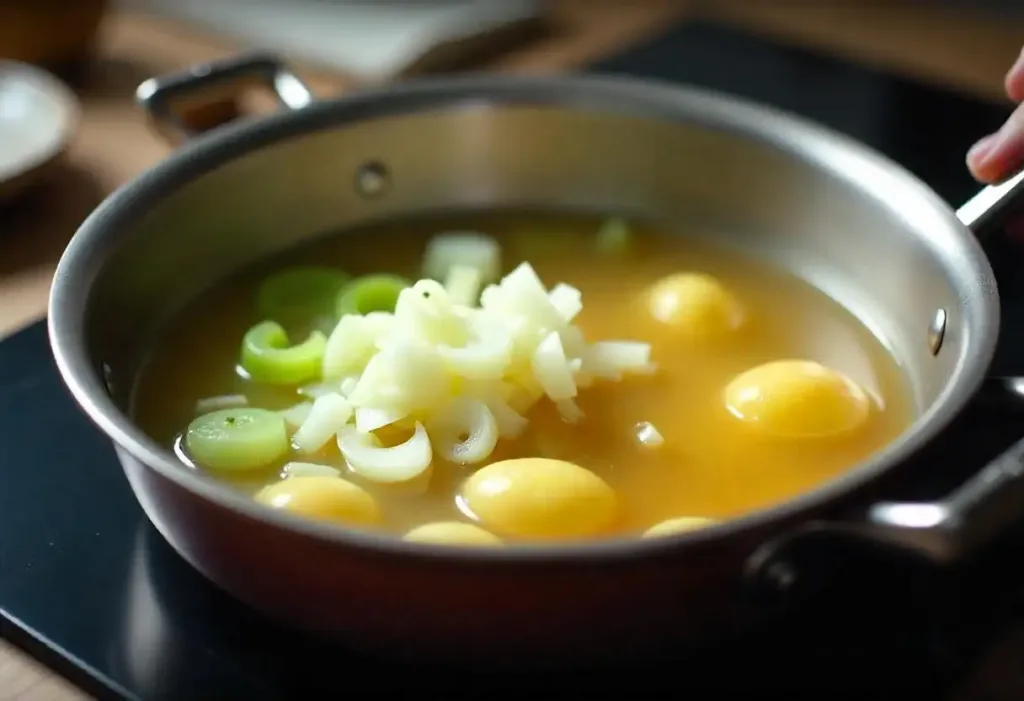Picture this: a classic drizzly Portland evening, you’re cozy inside, and the comforting aroma of leek and potato soup is *supposed* to be filling your kitchen. But… wait. You take a taste, and it’s just… *meh*. Sound familiar? If you’ve ever sighed and wondered, **why is my leek and potato soup bland?**, you are SO not alone! It happens to the best of us, myself included (don’t tell Mike!). This classic soup *should* be a hug in a bowl, but sometimes it falls flat. The good news? It’s totally fixable! So, grab your apron, maybe pour a glass of wine, and let’s go on a flavor rescue mission. I’m sharing my best tips to take your soup from blah to *brava*! We’ll turn that disappointment into pure deliciousness, guaranteed!
Why Is My Leek and Potato Soup Bland?
So, you followed the recipe, chopped the veggies, simmered away… and the result is just… lacking that *oomph*. Mamma mia, it’s frustrating! But trust me, it’s usually not you, it’s the little details. There are a few usual suspects when we ask, **Why is my leek and potato soup bland?** Maybe we were a bit timid with the salt shaker (Nonna Rosa always said, “Don’t be scared of salt, Sofia!”). Maybe the broth was a bit sad and watery to begin with.
Or maybe we rushed the process and didn’t let those lovely flavors really get to know each other in the pot. Hey, kitchen mishaps happen! I once made a soup so bland even Mia (my little chatterbox who eats *everything*) politely pushed it away. But don’t you worry, we can totally figure this out together. Let’s look at the common culprits.
Common Mistakes That Lead to Bland Soup
Okay, real talk. What usually trips us up and leads to flavorless soup? Skipping the first steps is a big one – you gotta gently sauté those leeks (and maybe some onion or garlic!) to coax out their sweetness. That’s flavor base numero uno! Using a weak, watery broth? That’s like building a house on shaky ground – the whole thing suffers. And the biggest crime? Under-seasoning! Nonna Rosa would have a fit! Seasoning throughout the cooking process, not just at the end, is key. These little things make a massive difference, but the good news is, they’re easy fixes!
The Role of Ingredients in Flavor
Let’s talk ingredients – the heart and soul of your soup! Using fresh, vibrant leeks makes a world of difference. Look for ones that feel firm, with bright green tops (I love grabbing them at the farmers market!). The *type* of potato matters too – starchy ones like Russets or Yukon Golds break down beautifully and make the soup naturally creamy. And please, oh please, use a good quality broth or stock! Whether it’s chicken or veggie, a flavorful broth is your secret weapon. It’s the difference between a solo singer and a full choir! Especially if you’re following a great guide like the James Martin leek and potato soup recipe, starting with good ingredients is half the battle!
Adding fresh herbs later on? Even better! Think of it like casting characters for a play – you want the best actors (ingredients!) to create a memorable performance (delicious soup!). Choosing quality makes bland soup much less likely.
Balancing Seasoning for Optimal Taste
Okay, let’s get salty! But seriously, seasoning is *everything*. Salt isn’t just about making things salty; it enhances all the *other* flavors. The golden rule? Taste, season, taste again! Start with less than you think you need, especially if your broth is already salted, and add more gradually. Freshly ground black pepper adds a lovely warmth – way better than the pre-ground stuff! And here’s my secret weapon for brightening things up: ACID! A tiny squeeze of fresh lemon juice or a splash of white wine vinegar right at the end wakes up all the flavors without making it taste sour. It’s like turning the lights on in the flavor room! Finding that perfect seasoning balance is what makes a soup truly sing.
Layering Flavors for Depth
Flavor isn’t built in one step; it’s layered, like a good lasagna! Start by *gently* sautéing those lovely leeks (and maybe some onion/garlic) in butter or olive oil until they’re soft and sweet – don’t rush this! You’re building flavor foundation #1. See those yummy brown bits sticking to the bottom of the pot? That’s flavor gold! Don’t scrub it away – *deglaze*! Splash in a little white wine or broth and scrape those bits up; they’ll dissolve into the soup adding amazing richness. Think of each step – sautéing, adding stock, simmering – as adding another layer of deliciousness. Depth, complexity, interest… that’s what we’re going for!
Enhancing Soup with Herbs and Spices
Ready for some flavor magic? Herbs and spices are your best friends here! Tossing in a bay leaf while the soup simmers adds a subtle, aromatic warmth (just fish it out before blending!). A sprig of fresh thyme brings a lovely earthy note that pairs perfectly with leeks and potatoes. Feeling a little fancy? A tiny pinch of freshly grated nutmeg adds a surprising cozy spice. And please, don’t forget fresh herbs at the end! Chopped parsley or chives sprinkled over the top right before serving adds a pop of freshness and color that makes all the difference. It’s like adding jewelry to your outfit – the perfect finishing touch!
The Importance of Texture in Soup
You know what? Texture totally plays a part in how we perceive flavor. A thin, watery soup just doesn’t hit the same comfort spot as something thick and creamy, right? To get that luscious, velvety feel, you don’t *have* to drown it in heavy cream (though a splash at the end is lovely!). You can simply blend a portion of the soup until super smooth, then stir it back into the pot with the chunkier bits. Or, make sure you use those starchy potatoes like Russets or Yukon Golds – they break down beautifully and thicken the soup naturally. When the texture is right, the flavor just feels more satisfying. Even my picky Luca is more likely to try a soup if it looks creamy and inviting!
How to Add Umami to Leek and Potato Soup
Umami – that mysterious fifth taste! It’s that savory, satisfying depth that makes food taste incredibly moreish. If your soup feels like it’s missing *something* you can’t quite place, it might need an umami boost! My Nonna Rosa’s trick? Toss in a Parmesan cheese rind while the soup simmers (remove it before blending). It adds incredible savory depth! Other ideas? A teaspoon of miso paste stirred in, a dash of soy sauce or Worcestershire sauce, or even sautéing some mushrooms along with the leeks. These little umami bombs add complexity and make your soup taste richer and more satisfying. It’s that secret ingredient that makes people go, “Wow, what *is* in this?!”
Fixing a Bland Soup After Cooking
Okay, disaster strikes – you’ve finished cooking, you taste it, and… *womp womp*. Still bland. Don’t throw in the towel! We can still save this soup! First, reach for the salt and pepper again – maybe it just needs a final adjustment. A swirl of heavy cream, a dollop of sour cream, or even a pat of butter stirred in can add richness fast.
A handful of grated sharp cheddar or Parmesan stirred in until melted? Instant flavor bomb! And never underestimate the power of fresh herbs chopped and stirred in right at the end, or that last-minute squeeze of lemon juice. Sometimes it takes a little experimenting – a dash of this, a sprinkle of that – but you can usually bring it back from the brink. Laugh it off, call yourself a soup doctor, and fix it up!
Creative Add-Ins for Flavor Boosts
Ready to get really playful and boost that flavor? Let’s think toppings and swirls! Crumbled crispy bacon on top? Mike would approve! A drizzle of good quality olive oil or even truffle oil? *Fancy*! Homemade crunchy croutons (maybe rubbed with garlic?) add fantastic texture. A swirl of pesto? Yes, please! Even just some toasted nuts or seeds add a nice contrast. These aren’t just garnishes; they’re flavor and texture power-ups that make each spoonful more exciting. Have fun with it!
How to Avoid Bland Soup in the Future
So, how do we prevent Bland Soup Syndrome from striking again? It boils down to a few key things: Start with good ingredients (flavorful broth!). Build layers of flavor (sauté!). Season thoughtfully and taste often! Don’t rush the cooking process – let those flavors mingle and develop. And most importantly? Have fun and don’t be afraid! Cooking is a journey, not a destination. Every pot of soup is a chance to learn and experiment. Embrace the process, channel your inner Nonna Rosa, put on some music, and enjoy creating something delicious!
FAQs
Q: How do you fix bland potato soup?
Check out this helpful article from The Spruce Eats on “How to Fix Bland Soup” – lots of great tips there!
Q: Why is my potato and leek soup tasteless?
Q: How to add more flavor to leek and potato soup?
Q: How do I fix bland tasting soup?
So there we have it, *amici*! Hopefully, you’re no longer wondering, “**Why is my leek and potato soup bland?**” and instead feeling empowered to create flavor-packed, soul-warming bowls of goodness. Remember, cooking is all about experimenting, tasting, and having fun! Don’t be afraid to trust your instincts, add a little extra ‘this’ or a pinch of ‘that’, and make the recipe your own. Taste as you go – it’s the most important step! I can’t wait for you to get back in the kitchen and whip up something truly delicious. Let me know how your soup turns out in the comments – share your successes, questions, or favorite flavor boosts! Happy cooking!



